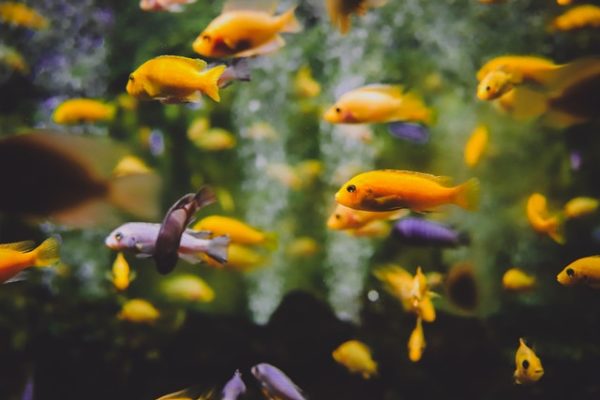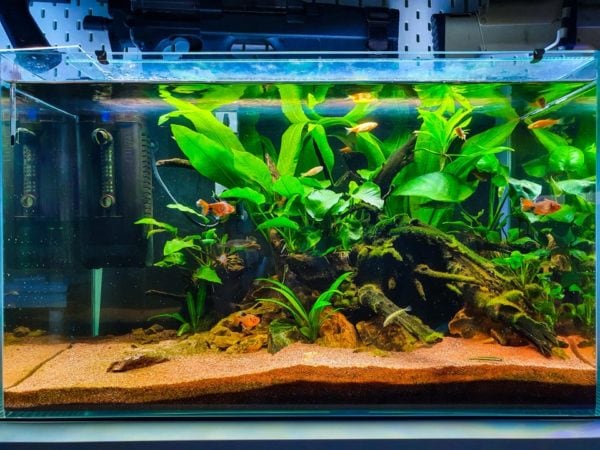Like in the normal world, the need for carbon dioxide and oxygen balance is equally important for the underwater. So if you have a community aquarium at home with live plants, be assured that they need proper Co2 levels.
The primary reason is because plants are composed of carbon. They absorb the carbon dioxide to propagate and grow. But, too much of anything is bad for the ecosystem. So, while the plants might eventually adjust to the high Co2, your fish won’t.
Excess carbon dioxide in the tank can lead to various complications, including killing the fish in the tank. However, you can optimize and regulate the levels with easy measures.
This article will discuss everything about signs of too much Co2 in the aquarium and how to fix the issue.
Table of Contents
Importance of CO2 in your Aquarium

So, the question arises, “Why does my aquarium need Co2?”
The primary objective of Co2 in the aquarium is to contribute to plant propagation. The carbon dioxide blends in with the other nutrients to promote the growth of the aquarium plants.
You’d be surprised how planned the procedures are. The aquarium plants use photosynthesis to generate energy, which combines with the free Co2 in the tank to produce nutrition.
Simultaneously, photosynthesis also releases oxygen into the tank water, helping the fish breathe.
The need for Co2 and O2 in the tank depends on the plants and fish. If you don’t have live plants, your tank will need oxygen externally. Similarly, if the tank has too much Co2, it can prove fatal for the fish species.
The floating live aquarium plants source most of the Co2 from the air. However, for the submerged plants, they’d need constant and optimal Co2 levels for functioning.
It is very rare for a home aquarium to have excess Co2 levels. The levels are critically low most of the time, and you’d need to inject excess from external sources. So, if the levels are high, it indicates something wrong with the overall water parameters.
Few aquarium plants like Anubias, ferns, etc., can thrive in low Co2 and low-light conditions. However, we’d recommend doing proper research before indulging in the same.
How to Measure Level of CO2 in an Aquarium?
Measuring the CO2 levels in the aquarium is crucial. Doing so reduces the toxicity risks in the tank and regulates the availability of the gas levels at optimal levels.
Since excess CO2 levels are toxic to the fish species in the tank, measuring the levels is important from time to time.
Analyzing pH Levels
If you use CO2 gas injections, we recommend checking the pH levels before injecting and after the gas.
A part of the CO2 in the aquarium water turns into carbonic acid, which reduces the water’s pH levels. So, you can compare the CO2 levels by comparing the pH before and after the injection.
Use Drop Checkers
Besides that, you can also use drop checkers to analyze the CO2 levels in the tank. However, they aren’t the most reliable as they depend on gaseous exchange in the water. Nevertheless, if you want an estimated level, these work well.
Look at Plant Growth

Since the aquarium plants depend on CO2 for their growth, you can gauge that to check the carbon dioxide levels.
Ideally, if the plant is propagating well and the fish species are happy in the tank, there’s nothing to worry about. However, if the plant is growing but the fish species aren’t responding, it is a sign of CO2 toxicity.
Whatever method you use, try to stay vigilant all the time. CO2 affects fish in the tank very quickly. So, if the levels are exponentially high, you’d need to act quickly.
What are the Safe Levels of CO2 in Aquariums?
The CO2 levels in the aquarium rely on oxygen levels.
Although the standard level of CO2 is measured at 30 ppm (mg/l), we’d recommend that you check the oxygen levels.
This means that if the oxygen level is very low, even the slightest increase in CO2 will affect the fish species in the tank.
CO2 toxicity is very harmful to the fish, leading to signs of lethargy, poor appetite, and death. Therefore, we’d recommend keeping a close eye on the fish as you inject CO2 into the tank.
You don’t want to overdo the levels, but at the same time, you don’t want the plants to die as well.
If you think the CO2 levels are exponentially high, we’d recommend changing the aquarium water immediately.
What are the signs of too much CO2 in Aquariums?
Excess CO2 in the aquariums directly affects the livestock, including the fish, shrimp, turtles, etc.
So, when testing for the CO2 levels in the tank, we’d recommend checking the health and activity of the fish.
If you find a sudden change in their habits, it might indicate unregulated carbon dioxide in the water.
Some common signs of high CO2 levels include:
Low pH – a very high CO2 will correspond to a very low water pH in the aquarium due to the formation of carbonic acid.
Reduced activity – since the fish species don’t respond well to high CO2, you will find them less active in the tank. Fish species that are normally active will keep to themselves and isolate themselves in the tank.
Change in position – if the CO2 levels in the water are high, it indicates a lack of proper oxygen. To compensate for that issue, some fish, shrimps, and crabs will navigate to the tank’s surface. If you find this prevalent, it is a sign of CO2 toxicity.
Erratic behavior – not just poor appetite, the fish start becoming restless and erratic in the tank with high CO2 levels.
These are some common signs of high CO2 in the water tank. However, every fish species reacts differently. So, some symptoms might be different than others. Therefore, we’d recommend you watch the activity in your tank closely to assess the issue.
How Do You Remove CO2 From an Aquarium?
CO2 toxicity can kill all your fish in the tank. So, it isn’t even a question that you must act fast. There are some effective ways in which you can regulate the CO2 levels.
Let’s discuss them in detail here.
1. Adjust the Needle Valve
If you are an advanced aquarist with an integrated needle valve for CO2, adjust the levels. Your safe CO2 level is 30 PPM. So, anything above that will affect the fish.
Ideally, the easiest way of fixing the issue is by adjusting the needle valve. We’d recommend reducing the CO2 levels.
Also, if the dissolved carbon dioxide is already optimal, avoid injecting excess into the tank until the levels reduce again.
2. Aerate the Tank
CO2 toxicity isn’t only when the levels are above 30 ppm. Ideally, it depends on the oxygen levels in the tank too. If the O2 level is very low, even the slightest increase in CO2 will alter the balance.
So, if your tank already has high CO2, the easiest way to fix that is by aerating the tank.
Oxygenating the tank allows the fish to breathe freely and without any hassle. There are several oxygen pumps for aquariums that you can install.
3. Large Water Change
Lastly and possibly the most effective is a 50% water change. This allows immediate reduction of the CO2 levels in the tank and allows the fish to thrive in the aquarium.
However, if you are changing the water, make sure you have the new water prepared on the side. The water you will add to the tank should match the tank inhabitants’ general parameters.
FAQs
More than 30 PPM of CO2 is toxic for the fish in your aquarium. Although it might not kill them immediately, not fixing the issue eventually will claim their lives.
Most aquarium plants can thrive in CO2 levels between 20-30 PPM in the aquarium. There are a few exceptions like ferns and Anubias that can thrive in low carbon dioxide.
Excess CO2 levels in the aquarium aren’t harmful to your aquarium plants. They can thrive in excess levels and propagate without any complications. However, the fish species are at risk of death due to too much CO2.
Sustained high levels of CO2 in the tanks can eventually harm the plants. The low pH levels can not just kill the fish but also inflict damage to the roots of the plants. This will stunt their growth and affect the plant’s appearance and development in the tank.
The main cause behind algal growth stems from low CO2 and nutrient imbalance. However, high carbon dioxide isn’t associated with algal growth in the tank.
Wrapping Up
Adding live plants to your aquarium is crucial, but it comes with challenges too. For example, excess CO2 levels in the tank might support your plant’s growth but is equally fatal for your fish. So, regulating the levels is needful.
We hope this article answers all your questions in detail. Ensure that you stay vigilant while taking care of your aquarium plants.

